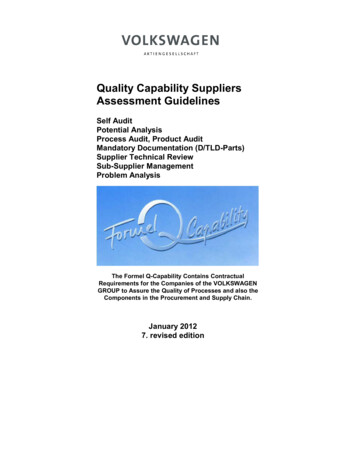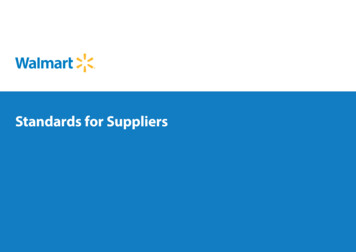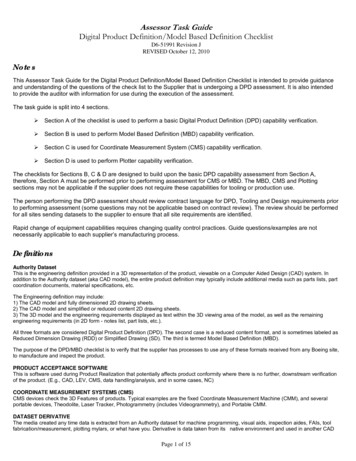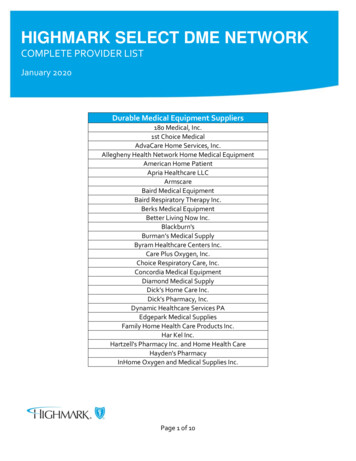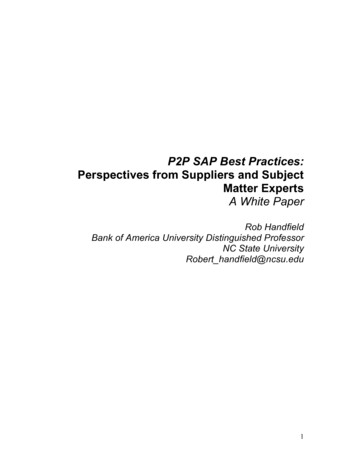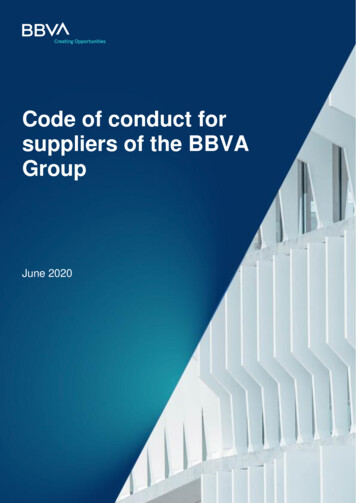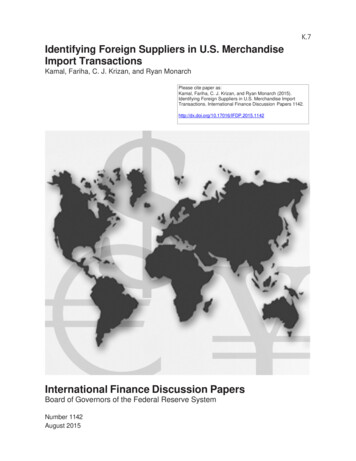
Transcription
K.7Identifying Foreign Suppliers in U.S. MerchandiseImport TransactionsKamal, Fariha, C. J. Krizan, and Ryan MonarchPlease cite paper as:Kamal, Fariha, C. J. Krizan, and Ryan Monarch (2015).Identifying Foreign Suppliers in U.S. Merchandise ImportTransactions. International Finance Discussion Papers rnational Finance Discussion PapersBoard of Governors of the Federal Reserve SystemNumber 1142August 2015
Board of Governors of the Federal Reserve SystemInternational Finance Discussion PapersNumber 1142August 2015Identifying Foreign Suppliers in U.S. Merchandise Import TransactionsFariha KamalC.J. KrizanRyan MonarchNOTE: International Finance Discussion Papers are preliminary materials circulated to stimulatediscussion and critical comment. References to International Finance Discussion Papers (otherthan an acknowledgment that the writer has had access to unpublished material) should becleared with the author or authors. Recent IFDPs are available on the Web atwww.federalreserve.gov/pubs/ifdp/. This paper can be downloaded without charge from theSocial Science Research Network electronic library at www.ssrn.com.
Identifying Foreign Suppliers in U.S. Merchandise Import TransactionsFariha Kamal*C.J. Krizan**Ryan Monarch***Abstract: International trade data capturing relationships between importing and exporting firmsprovides new insight into the activity of trading firms, but the quality of such disaggregated datais unknown. In this paper, we assess the reliability of two-sided data from the United States bycomparing the number of foreign suppliers from U.S. import data to origin-country data. Suchexporter counts tend to be lower than the same counts from raw U.S. data. We propose andimplement a set of methods that align the totals more closely. Overall, our analysis presentsbroad support for usage of U.S. data to study buyer-supplier relationships.Keywords: International Trade, Transactional RelationshipsJEL classifications: F10, L14*Center for Economic Studies, U.S. Census Bureau. Contact: fariha.kamal@census.govCenter for Economic Studies, U.S. Census Bureau. Contact: cornell.j.krizan@census.gov***The author is a staff economist in the Division of International Finance, Board of Governors of theFederal Reserve System, Washington, D.C. 20551 U.S.A. The views in this paper are solely theresponsibility of the author(s) and should not be interpreted as reflecting the views of the Board ofGovernors of the Federal Reserve System or of any other person associated with the Federal ReserveSystem. Contact: ryan.p.monarch@frb.gov**Any opinions and conclusions expressed herein are those of the authors and do not necessarily representthe views of the U.S. Census Bureau, the Board of Governors of the Federal Reserve System, or of anyother person associated with the Federal Reserve System. All results have been reviewed to ensure that noconfidential information is disclosed. Special thanks to Hong Ma, Jeronimo Carballo, and Christian VolpeMartincus for sharing data. We thank Javier Miranda for valuable comments. Clint Carter and WilliamWisniewski were extremely helpful with data requests and disclosure processes. All errors are ours.
1IntroductionEvery international trade transaction is an agreement between two firms, an importer (buyer)and an exporter (supplier), located in two different countries. For this reason, the recentavailability of international trade databases that provide the identity of both importers andexporters for individual transactions has fundamental appeal for the field of international trade.Indeed, the existence of such “two-sided” firm trade transactions data has the potential toestablish novel facts about traders that can augment the heterogeneous firm framework widelyused throughout the literature (Melitz (2003)). To the best of our knowledge, “two-sided” firmtrade transactions data has been analyzed for Colombia (Benguria (2014)), Chile and Colombia(Blum et al. (2013)), Costa Rica, Ecuador, and Uruguay (Carballo et al. (2013)), Norway(Bernard et al. (2014)), and the United States (Bernard et al. (2010); Pierce and Schott (2012);Dragusanu (2014); Eaton et al. (2014); Kamal and Sundaram (2013); Monarch (2014)).The use of two-sided firm data in international trade research is still in its infancy andit may be fair to characterize the use of such data as cautious. One of the primary reasonsis concerns about data quality: in order to have individual transactions that include bothimporting and exporting entities, one data source must identify individual traders in bothcountries. It is readily apparent that one country collecting information on exporters originatingin another country will be an imperfect undertaking at best. While it is in the best interest ofmany governments to collect reliable information about firms located in their jurisdiction fortaxation purposes, it is not obvious that the same governments would have the incentive, oreven the authority, to maintain accurate statistics on firms located outside its national borders.Subsequently, two-sided trade data will by definition be more susceptible to issues related tothe unique and consistent identification of “foreign” suppliers. The purpose of this paper isto examine and assess the reliability of two-sided firm trade data sourced from the UnitedStates, specifically U.S. merchandise import transactions collected by U.S. Customs and BorderProtection (CBP) and maintained by the U.S. Census Bureau.1We begin by describing the institutional environment surrounding the construction andcollection of the identifier that captures foreign suppliers exporting to the U.S, known as theManufacturer ID or MID (section 2). The source data is the U.S. merchandise import transactions, which consists of information from every customs form filled out by U.S. firms with1See p.html for further description.4
import shipments above 2,000. Using this data as well as supporting evidence sourced fromCBP and third parties, we investigate the properties of the Manufacturer ID, highlighting bothpitfalls and benefits in using the MID to conduct research. Our goal in this paper is to assess theextent to which the Manufacturer ID represents the foreign supplier. In Section 3, we comparestatistics on foreign suppliers generated using the U.S. data to what are, theoretically, the samestatistics generated using customs data from selected source country databases, compiled in theWorld Bank’s Exporter Dynamic Database. Trade data from countries exporting to the U.S.originate from official statistical sources, so it is reasonable in our view to attempt to validatethe Manufacturer ID via such a comparison. Where possible, we augment these results withmore detailed country-specific comparisons. Our main finding is that the raw U.S. data tends toovershoot the number of foreign exporters by about 25 percent. Additionally, certain countriesand industries match well, while others do not. Given this finding, in Section 4, we proposeseveral algorithms and cleaning methods to modify the MID and generate statistics that alignmore closely to source-country data.Overall, our findings are broadly supportive of the usage of the U.S. import data for thepurposes of investigating buyer and supplier relationships in international trade. Our analysissupports the usage of the Manufacturer ID as a unique and consistent identifier of foreign-basedexporters that transact with U.S. importers, and thus as a window into the two-sided matchingdimension of international trade research.2Background and HistoryU.S. importers are required to fill out CBP Form 7501 in order to complete importation of goodsinto the United States. In addition to information about value, quantity, and 10-digit HTSUSproduct category of the imported merchandise, firms also have to provide the “Manufacturer ID”(MID) for each product in Box 13 (see Figure 1).2 Due to strict rules-of-origin requirements, theMID for textile shipments represents the “manufacturer” as defined in Title 19 Code of FederalRegulations (CFR), i.e. “the entity performing the origin-conferring operations”.3 Textileproducts include both textile or apparel products as defined under Section 102.21, Title 19,23See also http://forms.cbp.gov/pdf/cbp form 7501.pdf.See /pdf/CFR-2011-title19-vol1-sec102-23.pdf5
CFR4 , classified as any products in two-digit HS codes 50 through 63.5 In general, for allproducts, CBP requires that the manufacturer ID constitute the manufacturer and not tradingcompanies, or other trading agents.Customs Directive No. 3550-055 lays out the current method for deriving an identificationcode for manufacturers and shippers.6 The MID consists of an alphanumeric code that isconstructed according to a pre-specified algorithm, using information on the sellers name andaddress from the importers official invoice. The derivation (known as “keylining”) is as follows:the first two characters of the MID must contain the two-digit ISO country code of origin ofthe good, the next three characters the start of the first word of the exporters name, the nextthree characters the start of the second word, the next four characters the first numbers of thestreet address of the foreign exporter, and the last three characters the first three letters of theforeign exporters city (see Table 1 for stylized examples).7 The MID has a maximum length offifteen characters.The multi-step process for constructing the MID described above may cause concerns aboutits reliability as a usable identifier, or the susceptibility of the MID to erroneous data entryby either importing firms or customs brokers. Although CBP Form 7501 may be filled out byindividual importers it is common to either employ in-house licensed customs brokers to facilitatethe import process or use outside customs brokerage service providers to handle the shipmentclearance process. Customs regulations, 19 CFR, Part 111, require that a customs brokerhold a valid license to transact customs business on behalf of others, and in fact, the CustomsBroker License Examinations8 administered by CBP typically includes a question about MIDconstruction.9 Moreover, customs brokers utilize specialized software to prepare and transmitinvoices electronically to CBP such as SmartBorder.10 SmartBorder includes validation checkson the entry data. In particular, with respect to the MID, the SmartBorder software canstore customer information that can auto-populate, thereby reducing errors due to manual dataentry. Overall, 96 percent of all entries filed with CBP are filed electronically through the4See R-2011-title19-vol1-sec102-21.pdfSee http://hts.usitc.gov/ for details on each HS chapter.6See tion-code.7See Block 13 (pg. 7) for description of MID and Appendix 2 (pg. 30) for instructions on constructing MIDat http://forms.cbp.gov/pdf/7501 instructions.pdf.8See http://www.cbp.gov/trade/broker/exam/announcement for details about the exam.9See oms-broker-license-examinations-answer-keys for5sample exam questions and answer keys. Questions 5 and 12 on the April 2014 examinations ask about MID construction.10See derABI.aspx.6
CBPs Automated Broker Interface (ABI).11 Together these details allay some concern aboutthe potential for misspellings leading to errors in the construction of the MID. In terms of datacoverage alone, the MID is a well-populated variable in the U.S. merchandise import transactionsfor all years between 1992 and 2008. On average about 10 percent of the MIDs are missing byvalue while only about 3 percent are missing by count.What possible incentives would the U.S. government have for making sure that U.S. firmsare writing down the identity of their foreign partners correctly? According to U.S. law, thereare two apparent reasons. First, the MID is utilized in national security programs such asthe Customs-Trade Partnership Against Terrorism (C-TPAT). An active MID is required to bequalified for the program. Companies that join C-TPAT “sign an agreement to work with CBPto protect the supply chain, identify security gaps, and implement specific security measuresand best practices.12 C-TPAT members are less likely to be subject to examinations at the portsince they are considered “low-risk”. The CBP reports that the program covers about 10,000companies, accounting for over 50 percent of U.S. import value.Second, the United States is clearly interested in enforcing trade-related regulatory requirements that relate to the identity of foreign suppliers to the U.S. For instance, anti-dumpingmeasures are foreign-firm specific in nature. Furthermore, it is clear from U.S. regulations thatthe Manufacturer ID is used to track compliance with U.S. restrictions for textile shipments.MID criteria for textiles are more stringent than those for other products, since non-textileproducts typically do not have the rule-of-origin restrictions that exist for textile and apparelproducts. As mentioned earlier, the official “manufacturer” of textile products must be identified through a MID, pursuant to Section 102.21 or 102.22, Title 19, CFR. A single entry filedfor textile products of more than one manufacturer require that the products of each manufacturer be separately identified. If an entry filed for such merchandise fails to include theMID properly constructed from the name and address of the manufacturer, the port directormay reject the entry or take other appropriate action. The above discussion highlights theregulatory imperatives to provide an accurate MID and thereby establishes our confidence thatit provides a consistent basis of iden
by either importing rms or customs brokers. Although CBP Form 7501 may be lled out by individual importers it is common to either employ in-house licensed customs brokers to facilitate the import process or use outside customs brokerage service providers to handle the shipment clearance process. Customs regulations, 19 CFR, Part 111, require that a customs broker hold a valid license to .

